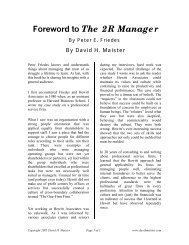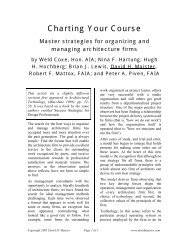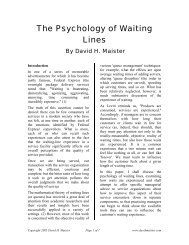pdf version - David Maister
pdf version - David Maister
pdf version - David Maister
You also want an ePaper? Increase the reach of your titles
YUMPU automatically turns print PDFs into web optimized ePapers that Google loves.
Results and Rewards in The Multi-Group Firm<br />
In addition, firms need to be<br />
conscientious in demonstrating that a<br />
star partner in an unprofitable office can<br />
be rewarded like a star, while an<br />
underperforming partner in a stellar<br />
office does not get a free ride.<br />
Measuring ResultsC<br />
If local office or group results are to be<br />
considered, the question arises as to how<br />
these should be measured. The answer is<br />
not as obvious as it might appear.<br />
First, there exists the issue of developing<br />
a “balanced scorecard” that tracks not<br />
only financial results but also the other<br />
goals that any professional group needs<br />
to achieve to be deemed a success.<br />
Included in such a balanced scorecard<br />
would be measures of client satisfaction,<br />
the group’s ability to develop its people,<br />
its contribution to firmwide assets such<br />
as shared tools and research, and the<br />
group’s contributions to firmwide<br />
success.<br />
Few if any firms have a balanced<br />
scorecard organized in a formal way,<br />
although most claim to make judgmental<br />
assessments of these factors.<br />
Even on the financial front, much<br />
confusion exists. At this point most<br />
firms have progressed to using “profit<br />
per partner” (or “profit per officer” in<br />
firms that are not partnerships) as a<br />
measure of practice group success,<br />
although even this is not always a clear<br />
guide to which groups have performed<br />
well and which have not. (To see this,<br />
consider Figure 1.)<br />
What this reveals is that profit per<br />
officer is the simple multiplication of<br />
four key submeasures: margin, rate,<br />
utilization (also referred to as<br />
chargeability or billability) and leverage.<br />
Two of these four factors are what I term<br />
“hygiene” issues, while two others<br />
reflect changes in fundamental profit<br />
“health.” The two hygiene factors are<br />
margin and utilization, while the two<br />
health factors are rate and margin.<br />
To understand the difference between<br />
these categories, consider (as an<br />
illustration) two of the four ways of<br />
improving profit per officer: increasing<br />
utilization or increasing rate. One group<br />
may have improved its profitability by<br />
working more hours per person. Another<br />
may have achieved exactly the same<br />
profit improvement by working the same<br />
number of hours per person as the<br />
previous year but by raising its rate per<br />
hour through some combination of client<br />
service, specialization, innovation or the<br />
bringing in of higher-rate transactions.<br />
These two groups may have achieved the<br />
same profit per officer improvements but<br />
their accomplishments are not<br />
commensurate. Increasing utilization (or<br />
hours worked) means you made more<br />
money because you worked harder.<br />
It is a nontrivial accomplishment, but it<br />
is primarily a short-term achievement. I<br />
call it the donkey strategy—achieving<br />
more by pulling a heavier load.<br />
However, a group that made more<br />
money, not by working harder but by<br />
getting the market to place a higher<br />
value on each hour worked, has<br />
accomplished something much more<br />
profound and longer lasting by definition<br />
because they have made themselves<br />
more valuable in the marketplace.<br />
The same argument can be made for the<br />
difference between margin and leverage.<br />
Improving margin is (mostly) about<br />
controlling overhead expenses—<br />
important, but nevertheless hygiene. But<br />
a group that finds a way to deliver its<br />
Copyright 2005 <strong>David</strong> H. <strong>Maister</strong> Page 2 of 2 www.davidmaister.com











